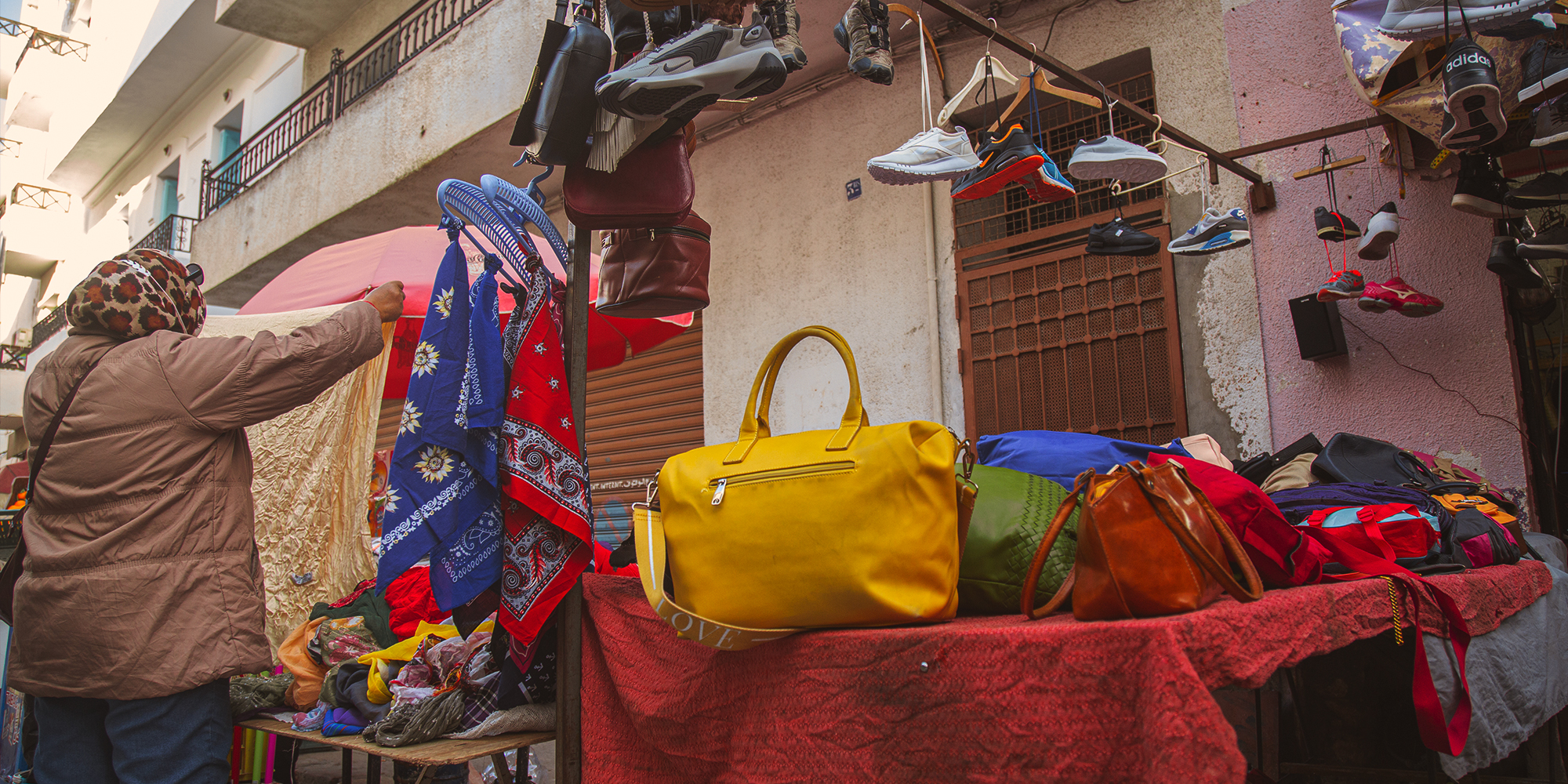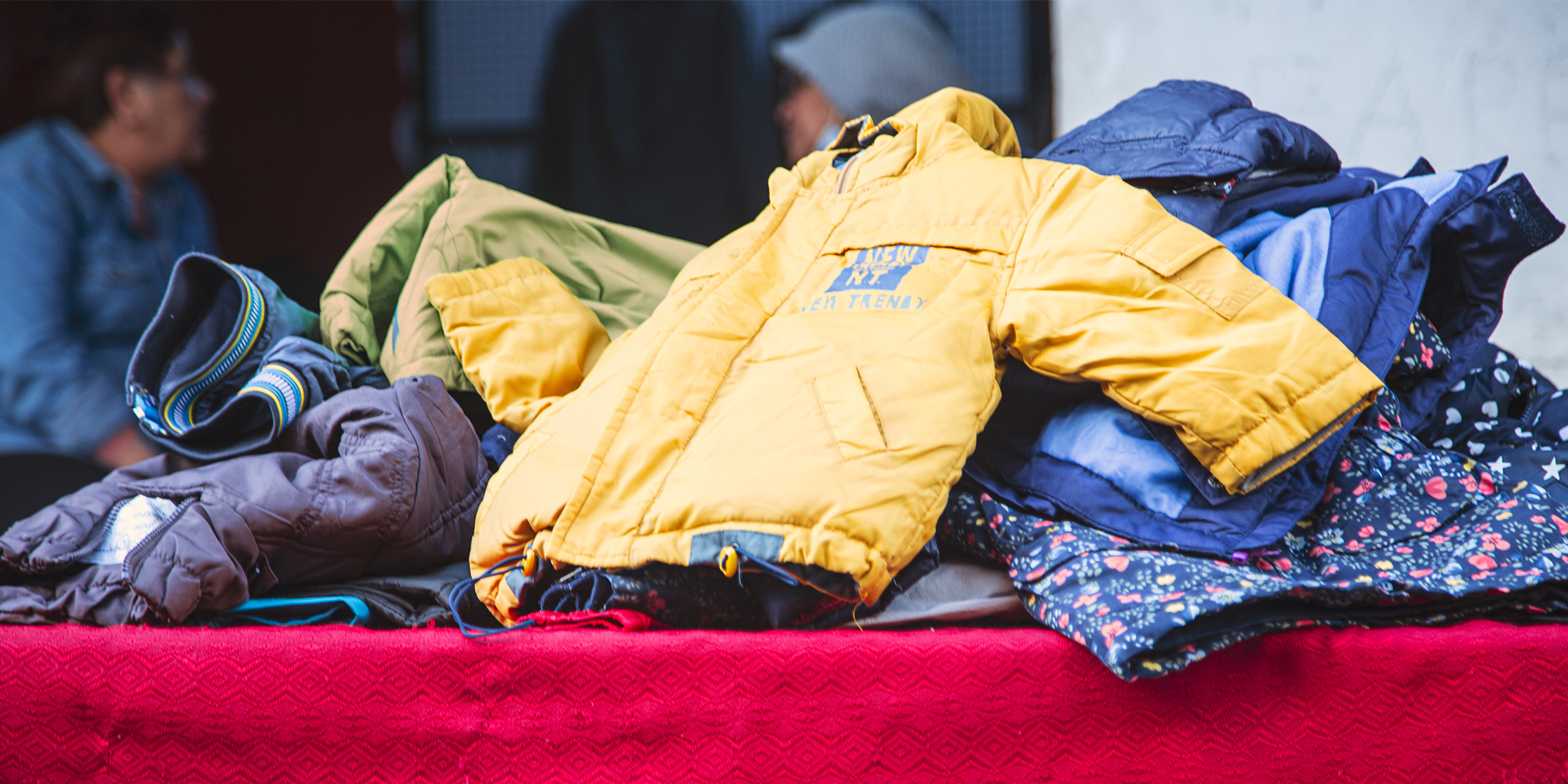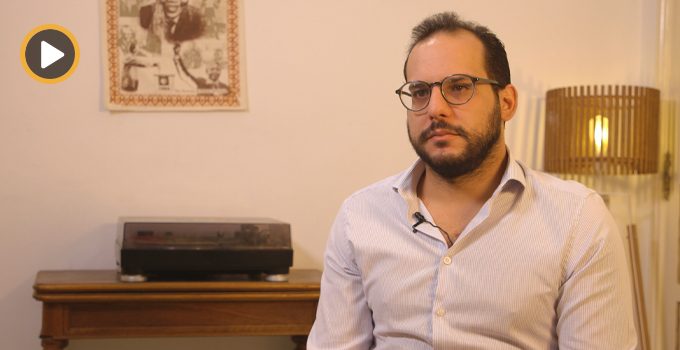In the northern district of old Tunis near Bab El Khadra, the souk at Sidi Bahri is a destination for anyone on a shoestring budget. From Madrid Street, one is projected into a market lined with shops and stalls offering a variety of merchandise. Stands piled with fruits and vegetables are set out next to others displaying used clothes and everyday household items.

At 10am, there is little foot traffic where vendors are selling used clothing. And yet compared with the soaring prices of new clothing, merchandise here is a bargain. At Houssem’s stall, women’s sweaters—some of whose tags bear the names of well-known designer brands, are just 500 millimes. Khaled sells all kinds of shoes for seven dinars a pair. Vendors do their best to attract customers to their stands. « Just five dinars a bag, ladies » yells one seller. His chant overlaps the voice of a colleague advertising men’s shirts at three dinars a piece.
94% of Tunisians are customers at the fripe
Such deals never cease to entice market regulars. 30-year-old Anissa comes specially from Cité Olympique for her weekly grocery shopping. Laden with bags of vegetables, Anissa wasn’t planning to treat herself to a pair of boots. But the price of shoes at Khaled’s stall drew her in.
« Here, low prices don’t mean inferior quality. Secondhand boots last longer than what you purchase in a boutique », she remarks.
Nor can Ines pass up a good bargain. The young mother quickly peruses the children’s clothing laid out in a stall where sweaters cost one dinar. She is accompanied by her six-year old son, who is trying on the sweaters his mother pulls out of the pile. A native of the neighborhood, Ines purchases « everyday clothes » from the fripe. New clothes are only for special occasions—back to school, Aïd, etc. Dalila, a grandmother from Menzah who is shopping for her nieces, tells Nawaat,
Kids grow fast, so dressing them in new clothes costs families a fortune.
These customers are among the approximately 94% of Tunisians who dress in secondhand clothing, according to Sahbi Maalaoui, president of the National Chamber of Secondhand Wholesalers that is affiliated with the UTICA. The market’s regular customers plan their visits around the unloading of new bales of clothes each week.

Tunisians’ passion for secondhand clothing has increased along with the steady rise in prices for new clothes. Inflation affecting clothes items and shoes rose from 6.6% in April 2021 to 8.7% in December 2021, according to the National Institute of Statistics (INS). And Tunisia’s consumer price index increased for the third month in a row, settling at 6.6% in December compared with 6.4% the previous month.
A threadbare market
Customers we encounter at the market indicate that soaring inflation has also affected the used clothes sector. « The market is dead », Houssem reports to his boss about how sales are going that day. « People don’t even have enough to buy used clothes anymore », he tells us.
For Naima who is selling household linens at the market, the population’s dwindling purchasing power has been even more palpable in the last year. « Most of my customers were cultivated civil employees passionate about the fripe. They would pay in installments. Over the past year, they have disappeared. I understand—they no longer have the luxury of buying such things », she says sadly.
Standing next to a stall of shoes, 40-something-year-old Issam notes that even secondhand is no longer affordable for many Tunisians. « A pair of sneakers or jacket can cost hundreds of dinars. The quality is good, but it’s still secondhand », he complains.
Arguing in defense of market vendors, Khaled explains that increased prices at the wholesale level transfer to the price increase that consumers face at the retail level. « A bale used to cost about 150 dinars. Now it’s close to 700 dinars », Naima reports.
Similarly, Issam recounts that he recently purchased a bale of clothing for double what it used to cost. According to Sahbi Maalaoui, the increase reflects a cascade effect across the entire chain:
Consumers complain about increased prices. Retailers voice the same complaint with regard to wholesalers, who blame the price increase on factories. Factory owners, in turn, point to an increased financial burden: salaries, transport, etc.
The importation, transformation and distribution of secondhand merchandise are regulated by Decree 95-2396 of December 2, 1995. Concerned authorities include the Ministries of Commerce, the Interior, Finances, Industry and Social Affairs.

Factories in the sector are subject to industrial warehouse regulations and operate to import, treat and distribute secondhand clothing. Over 9 million tons of merchandise are imported each year, 30% of which is directed to the local market, and 30% for export to the African market. The rest ends up as scrap or is destroyed. Tunisia has 54 secondhand clothing factories, including five that work exclusively for export, and 28 that closed under pressure from heavy customs fines. Sahbi Maalaoui notes that the sector provides more than 200 thousand direct and indirect jobs.
The entire sector now faces the prospect of unemployment. « For the first time since 1944 when the industry was launched in Tunisia, we lack merchandise. In 2021, the quantity of merchandise imported dropped by over 50% » Maalaoui told Nawaat.
International instability
The scarcity of merchandise, as Maalaoui explained, is a consequence of changing consumer patterns in the West, especially since the Covid-19 outbreak. « We import secondhand clothing from Europe and North America. Populations in these countries, destabilized by the health crisis and now working from home, aren’t buying as much new clothes. Instead, they are purchasing secondhand ». In France, for instance, wearing used clothes has become a fashionable ecological act.
This shift in consumer habits in the West has evolved as Tunisia has witnessed a transformation in how merchandise is sold. With secondhand goods now available online, market retailers are finding it increasingly difficult to obtain merchandise.
« We now have to pay bribes and seek special favors to obtain our merchandise », Naima confides to Nawaat.
Besides under the table commissions paid to intermediaries, retailers must also reach into their pockets for certain police officers. Khaled characterizes the « spoliation » of retailers which occurs in the transfer of bales of merchandise : « We are regularly questioned by police. In order to avoid the confiscation of our merchandise, considered illegal, we must give them money ».
Opacity pervades the market, creating an environment that is conducive to embezzlement and contraband. The sector has also served as a cover for selling illicit products. Moreover, many vendors flout sector regulations, selling items prohibited in their line of work such as shoes or children’s toys.

The confiscation of merchandise that is transferred illegally is arbitrary. The Decree of 1995 prohibits the transfer of secondhand goods between governorates, and disperses the annual quota for sorted merchandise across the different governorates. Each governorate has a specific distribution quota for its local market.
Sahbi Maalaoui calls for abrogation of this provision: « In order to remedy the lack of merchandise, we must first eliminate the quota system for governorates, and redirect the 30% for export back towards the local market ». Such demands are approved by UTICA president Samir Majoul, who « has promised to lobby in their support before government », Maalaoui tells us.
In the meantime, vendors feel they are at an impasse. Naima fears the possibility of bankruptcy: « I rent the shop for 300 dinars a month. With the crisis that unfolded from competition with Chinese merchandise and only became exacerbated with Covid, I don’t know if I should continue working in this sector—after more than 15 years in the profession ». She adds, « And yet I’m lucky because my expenses are less than what other colleagues pay, with rent upwards of a thousand dinars per month ». Houssem is also considering changing his line of work: « I rent this spot for 90 dinars a week. Before, I could make ends meet earning 20 dinars a day. This is no longer the case, especially since I have to share meager earnings with my employer » the young man says ruefully.





Iam visiting for the first time, where are thrift markets or stires located